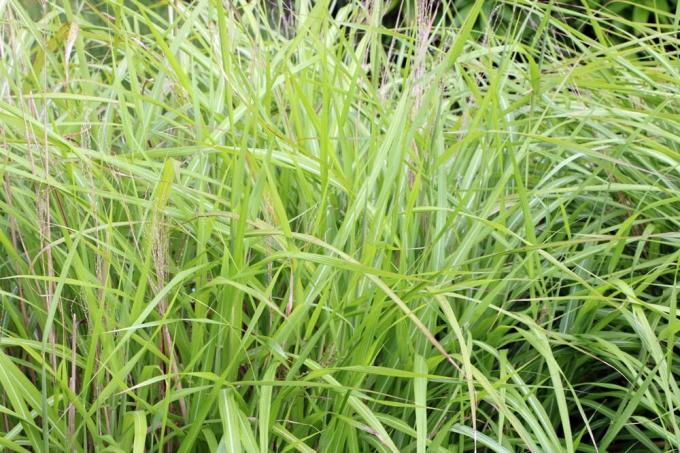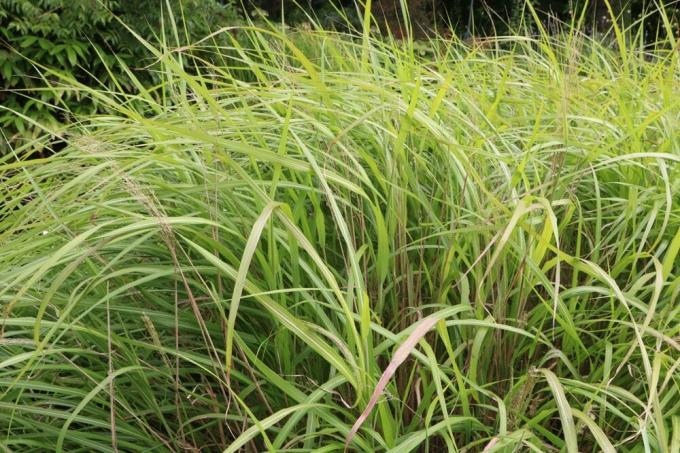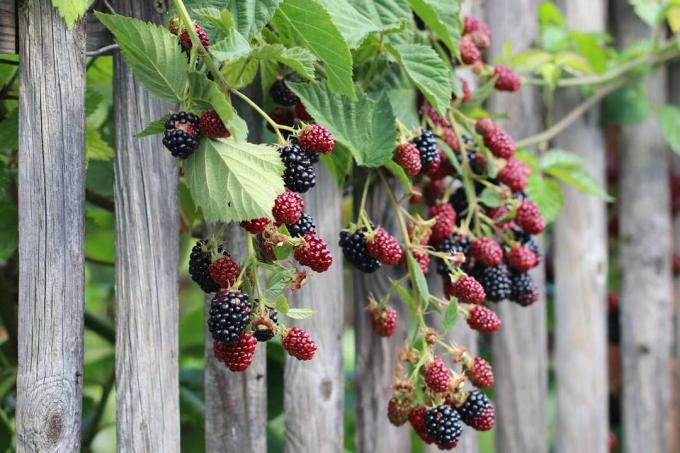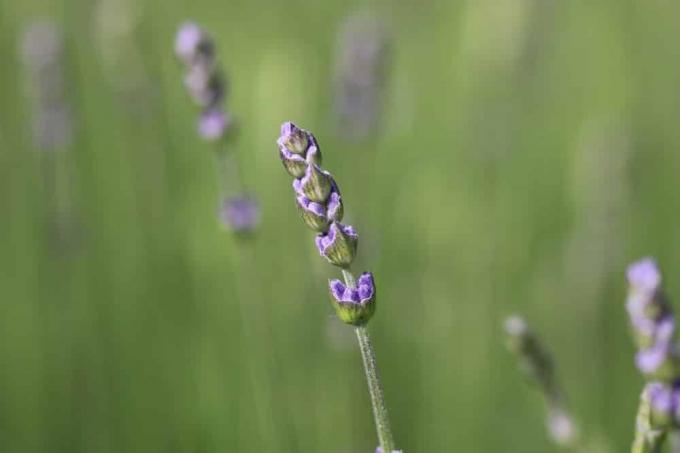

Table of contents
- When is the best time?
- Pruning beneficial?
- Cut Chinese reed correctly: instructions
- Cut back in autumn
- Tool
- Reuse instead of throw away
- Comb out miscanthus dwarfs instead of cutting them off
Chinese reed only demonstrates its robust winter hardiness of up to – 23.3 degrees Celsius when the strong culms protect the heart of the plant from moisture. The majestic leaves and stable stalks fulfill this task from autumn to spring, until the fresh stalks sprout. During this time, the nutrients are transferred from the leaves to the roots in order to create reserves for the coming season. This process can be recognized by the colorful discoloration of the leaves.
When is the best time?
- Best time: in March, just in time before budding begins
- Earliest date: after the last severe frost
- Latest date in winter-harsh mountain regions: in the month of May
When exactly you cut back the sweet grass depends to a large extent on the winter hardiness zone of your region. As long as a combination of wet and frost could affect the heart of the plant, leave the retracted leaves and stalks as a natural protective layer. However, you should not wait until the green tips of young blades of grass appear. A cut in the shoot leaves brown discolored wounds that do not regenerate.
Tip:
In autumn, tie the stalks of fine-cultivated varieties, such as Miscanthus sinensis 'Gracillimus', into a loose tuft. Thanks to this measure, the heart of the plant, which is sensitive to moisture, is protected from rain and snow. This precaution is not necessary for vigorous species such as giant Chinese reed or silver feather.
Pruning beneficial?
In the East Asian distribution areas, giant Chinese reed and smaller conspecifics thrive vigorously and healthily without human intervention. On the contrary, at the natural sites, extensive, closed stocks are formed, primarily in national parks and other protected regions. So the question is obvious why a pruning should be part of the care program at all. We have summarized the most important arguments for you here:
- The pruning creates space for a fresh, juicy green shoot
- Without pruning, dead stalks fly uncontrollably through the garden
- Regular cutting keeps the urge to spread in check

The invasive nature of Chinese reed is less pronounced than that exhibited by bamboo. Nevertheless, expansive clumps develop over the years, the dominance of which in creative garden design is not always desirable. If you cut back the stalks and ears consistently every year, you will have a regulating effect on the growth in width.
Cut Chinese reed correctly: instructions
There are countless varieties with individual attributes for creative garden design. The wide spectrum ranges from the delicate dwarf grass for the tub to the giant Chinese reed as a privacy screen. The uncomplicated care program, which essentially consists of annual pruning, has contributed to the worldwide popularity of Miscanthus sinensis as an ornamental grass. The cut is the same for all varieties. How to do it right:
- Cut back all stalks to a height of 15 to 25 cm
- Grasp the leaves in bunches and cut them off
- Collect plant parts that have fallen into the eyrie by hand
As a result of global warming, the grass is sometimes green earlier than expected. In this case, simply cut back the dead stalks to just above the stalk tips. For the next year, make a note of an earlier point in time in the care plan to shorten your Chinese reed close to the ground.
A notice:
Did you know that Chinese reed is a coveted winter home for numerous beneficial insects in your garden. Therefore, before pruning, carefully examine the eyrie for small hibernating residents. If you find what you are looking for, move it back a week or two.
Cut back in autumn
Under special circumstances, a pruning in autumn can make sense. For example, if the mighty ornamental grass thrives on the edge of ponds and streams, autumn storms blow numerous stalks onto the water surface. If home gardeners are bothered by the morbid appearance of withered grass, they like to grab their scissors as early as October or November.
In this context, it should be borne in mind that you are leaving the heart of the plant defenseless against the rigors of wintry weather. So that wetness in the nest cannot cause rot, please spread a breathable fleece over the planting site after pruning. The edges are fixed with stones or staples so that the protective cover does not fly off.
Remove the winter protection in good time before the start of the new growing season. Under normal weather conditions, the fresh budding starts in April at the latest. In regions with mild winters, the fleece should give way at the end of February/beginning of March so as not to hinder the growth of the first stalks.
Tool
Don't let the uncomplicated cut tempt you to underestimate the risk of injury when cutting back. The leaves of giant Chinese reed and other large to medium-sized varieties have razor-sharp edges. The stalks can cut into unprotected skin just as deeply as a freshly sharpened kitchen knife. The robust ornamental grasses easily defy conventional pruning shears, so the choice of the cutting tool requires special attention. We have put together for you what you can use to cut Miscanthus sinensis:
- Small Varieties: Bypass Secateurs
- Half-height to tall varieties: Two-hand pruning shears
- Giant varieties: hedge trimmer or handsaw
- gloves and long cuffs
- safety goggles
- spirit or alcohol
- Cloth

Despite its robust constitution, Chinese reed is not immune to diseases and pests. Therefore, please disinfect the blades and saw blades before and after the cut. To do this, moisten a cloth with spirit or alcohol and carefully wipe the cutting edges.
Tip:
The plant sap of Chinese reed can cause phototoxic skin reactions in sensitive people. Under the influence of sunlight, there is an interaction between the juice and human tissue. Therefore, please choose a cloudy day for pruning or protect your skin with gloves and long-sleeved clothing.
Reuse instead of throw away
Chinese reed is causing a sensation worldwide as a prime example of a 'low-input plant'. This term describes the special property of Miscanthus to provide maximum yield with the lowest energy input. Added to this are the outstanding strength properties of the stems, which are used in modern industry as a substitute for the plastic polystyrene. Coupled with an excellent suction capacity, the sweet grass is one of the most interesting plants for the future. You can also benefit from these attributes in your garden. Instead of disposing of the clippings carelessly on the compost, they are reused like this:
- Chop the stalks and use as mulch in the bed
- As a straw substitute in strawberry cultivation for clean fruit
- A natural base for ripening pumpkins to protect against soil moisture
- Ideally suited as bedding in animal cages or horse boxes
- As a loosening additive for potting soil and tub substrate
The stalks of giant miscanthus act as stable supports in ornamental and kitchen gardens, for example for peas or beans. Ecologically oriented gardeners tie small bunches together and place them in a semi-shady, sheltered location as a natural insect hotel for free.
Comb out miscanthus dwarfs instead of cutting them off
– instructions without scissors –
Specialist shops offer graceful varieties for the small garden and for cultivation in tubs. The delicate grassheads of 'Gracilmus', 'Little Zebra' and other hybrids do not demand necessarily after a cut back close to the ground, as these instructions require for the imposing conspecifics recommends. If you miss the perfect time to cut, simply comb out the dead ornamental grass with your hands. Put on sturdy gloves. Pull your hands repeatedly from bottom to top through the entire tuft, thin out the ornamental grass without damaging the fresh shoots.
 Home editorial office
Home editorial office
Learn more about pruning

Eucalyptus dried up: cut back now?
When a eucalyptus dries up, some owners immediately think of cutting it back. Because they want to see fresh green bud quickly. The chances of that happening may be good. But one thing must not be left out: research into the causes! Otherwise a new cycle of drying up and cutting begins.

Cut blackberries: Instructions for the right cut
Bramble branches only bear fruit for one summer, after which they are used up and die off in winter. It's a good thing that new canes grow back in time for the following year. Cutting care means: What no longer supports should be removed, young rods must be optimally trained.

cutting snowball | 13 tips for pruning
When it comes to snowballs (Viburnum), the opinions of numerous hobby gardeners differ when it comes to cutting. Main reason against pruning: Destruction of the natural appearance by pruning. Find out now when it is unavoidable and which tips should be heeded.

Cutting sage: 6 tips for cutting back
Cutting measures and their ideal time depend on the species of sage plants, because they have differentiated ways of life. There are woody and herbaceous representatives that require different attention. In order to carry out the measures, a basic set of tools is helpful.

Pruning hydrangeas: when is the right time?
Hydrangeas are a real beauty because of their flowers. In the long term, however, the flowering power is only maintained if regular pruning takes place. Because cutting off withered or dried plant parts offers protection. The following guide shows when this measure should be taken.

Cutting Lavender | When is the best time?
Lavender is a popular perennial, but difficult to cut. Without regular pruning, the shrub becomes lignified and less robust. Choosing the right time is important for pruning. When to cut depends on the use of the perennials.
